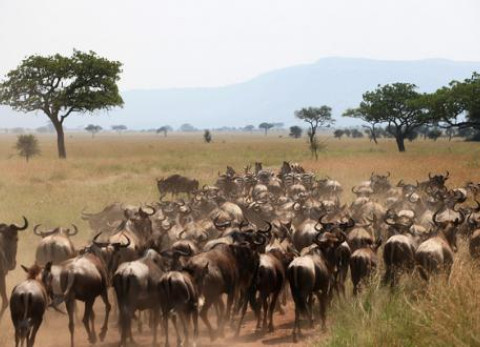Migratory animals create worldwide ecosystem

Migratory animals create worldwide ecosystem
We may believe the amount of travelling people do nowadays is impressive, but compared to the animal world, human travellers are mere amateurs. In Science magazine, NIOO-ecologist Silke Bauer and Bethany Hoye from Australia’s Deakin University take stock of research into animal migration.
Different species migrate for different reasons. Some do it in search of food, others for improved safety or to procreate. But what they all have in common is that they transfer nutrients, seeds, energy and/or diseases along the way. The impact these migratory animals have together on the global environment is enormous.
Living food transport
The researchers use herring as an example. When they reach their destination, Norwegian spring-spawning herring deposit a staggering 1.3 million metric tonnes of eggs and milt. That’s about the same weight as 50,000 trucks. Another example: desert locusts consume their own weight every day. One swarm in the horn of Africa was estimated to have destroyed enough vegetation on a daily basis to feed 400,000 people for an entire year.
Or take wildebeest: herds of up to a million migrate across the Serengeti each year in pursuit of food and water. The resident lions that prey on them, time their own reproduction to coincide with the wildebeest migration. In this way, the lions make sure there is enough food for their cubs. If there is a problem with the Wildebeest population, the lions suffer as well.
Outlawed
Research into the billions of animals wandering the globe has lagged behind. On the one hand there are migration specialists, who focus almost exclusively on the migrating species themselves. On the other hand there are ecologists, who tend not to consider migrants as they map communities in a particular location.
Bauer and Hoye believe it is time for a less narrow approach. Migratory animals often form a vital link between ecosystems that would appear to be completely separate at first glance. So the authors advocate that researchers from around the world join forces and collaborate more extensively.
Protecting migrants
They also warn that conservation efforts won’t be effective if countries only take into account resident animal populations. As they don’t stay in one place, migratory animals are effectively outlawed. Bauer and Hoye believe that given the vital contribution of these migrants to world ecosystems, protecting them should be made a priority.
Article: Migratory Animals Couple Biodiversity and Ecosystem Functioning Worldwide
S. Bauer & B.J. Hoye, Science 344, 1242552 (2014). DOI 10.1126/science.1242552, www.sciencemag.org
This research was partially through an NWO Rubicon-grant, awarded to Bethany Hoye with the purpose of gaining international research experience.
__________________________________________________________________________
The NIOO is one of the largest research institutes of the Royal Netherlands Academy of Arts and Sciences (KNAW), with more than 200 employees and students. It is specialised in fundamental and strategic ecological research. As of early 2011, the NIOO is based in a sustainably-built research laboratory in Wageningen, the Netherlands.
More information (not for publication):
- Silke Bauer, ecologist at NIOO-KNAW and the Swiss Ornithological Institute in Sempach, silke.s.bauer@gmail.com
